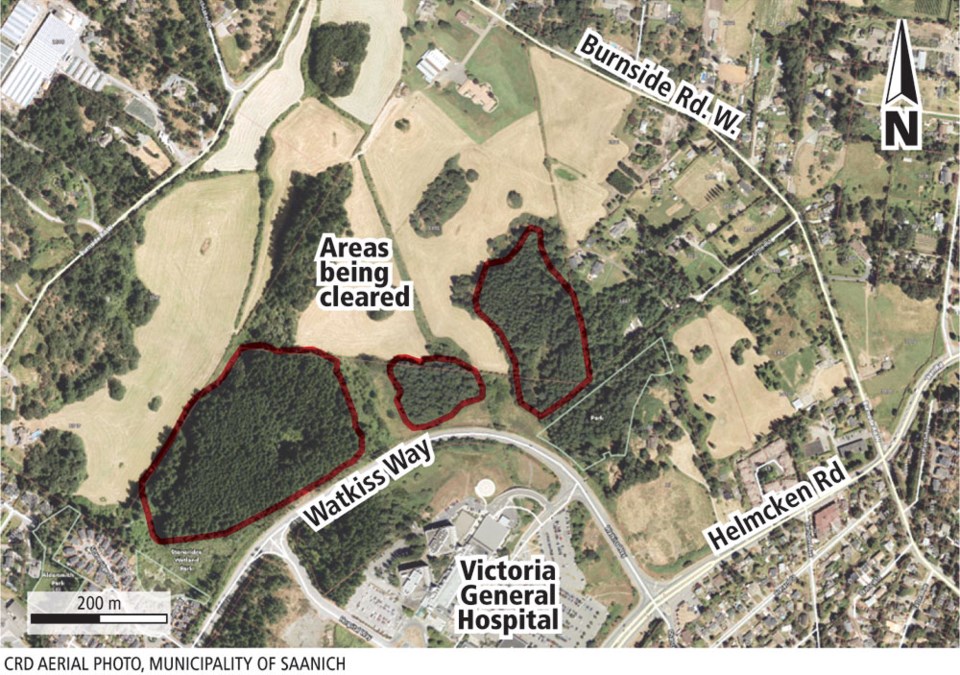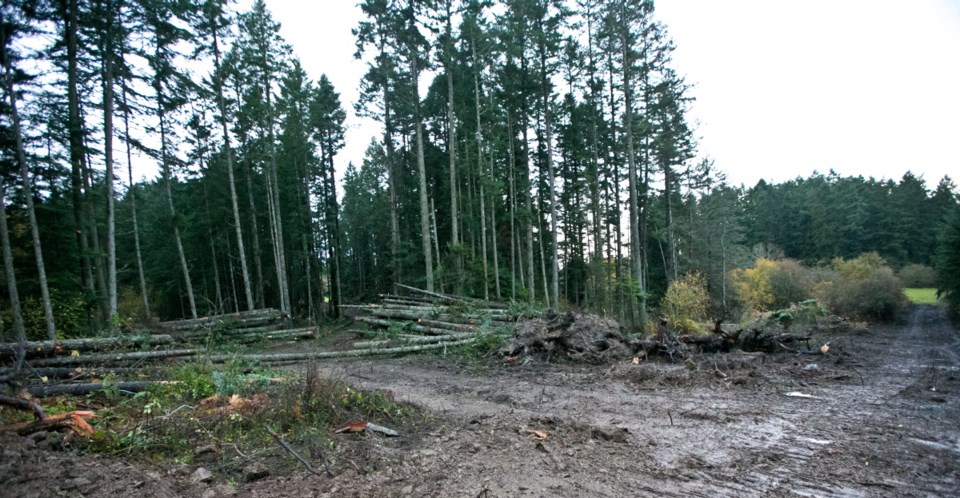The impending cut of nearly 5,000 trees on Watkiss Way to make way for a hay farm complies with Saanich and B.C. regulations, but has raised questions about the unintended consequences of recent council decisions, as well as concerns about climate change.
“I’m very disappointed that this significant area of forest will be taken down,” said Saanich Coun. Vic Derman.
The vast majority of the fir and cedar trees on 24 acres behind Victoria General Hospital — purchased two years ago by Allen Vandekerkhove — will be taken down.
“Doing so is certainly not consistent with Saanich’s desire to maintain tree cover,” Derman said. “It is also not consistent with the urgent need to respond to climate change. All in all, legal but certainly not desirable.”
Trees absorb carbon dioxide — the gas contributes to the greenhouse effect — emit oxygen and have a cooling effect on temperatures. The Saanich tree bylaw, which stipulates that trees cut down on private property be replaced by owners, does not apply to lands that are in the Agricultural Land Reserve or zoned agricultural. Provincial legislation allows trees to be cleared for farm use.
Given the loss of so many trees, it would have been wiser had council voted last summer to forward the site to Capital Region District directors for consideration for a sewage treatment plant, said Mayor Richard Atwell. That motion was defeated twice, 5-4 and on a 4-4 tie, largely because of opposition voiced by councillors to using a property in B.C.’s Agricultural Land Reserve for a sewage project, he said.
The consequences of that decision have now become “more clear,” Atwell said.
Coun. Leif Wergeland said the opposition to even that first step turned out to be “a big mistake on our part.”
Whether the Agricultural Land Commission would have been willing to take the property out of the ALR and the site found appropriate for a treatment plant would have been decided further along, Wergeland said.
The tree removal is “not a clear cut,” Wergeland said. “But it’s more trees than we’ve taken down in I don’t know how many years. It’s an impact for the whole region.”
The cutting, already under way, is perhaps the largest one-time loss of trees in 20 years, said Saanich Parks manager Doug Henderson.
The district’s tree canopy coverage was 39 per cent, based on 2009 data. “This will have reduced somewhat over the past couple of years and will be measured again in the next couple of years, likely under a regional initiative,” he added.
Vandekerkhove spent $100,000 on a proposal for a sewage treatment plant — which he said Saanich refused to look at. As a result, he said, he had no choice but to farm the long-standing greenbelt, which is zoned for agricultural purposes.
His spokesman, Ray Parks, has previously said Vandekerkhove was willing to sell or lease the Watkiss Way land, or trade it for other sites purchased by the Capital Regional District but ultimately rejected for sewage treatment.
Atwell, who supported sending the Watkiss site to the CRD, said a sewage treatment plant there had the potential to help solve the region’s problem of finding a suitable location while making “perhaps best use of the land by pairing heat recovery from the sewage plant with high-yield greenhouses on agricultural land.”
The mayor said Vandekerkhove’s intent had been to leave enough trees in place to seclude a plant from the roadway.
“Provincial right-to-farm legislation allows trees to be removed for farming and Saanich has little say in its use except for the permitting of tree removal once conditions are satisfied, which has now occurred,” he added.
In last year’s municipal election, a numbered company listing Vandekerkhove as its director gave $10,000 to Atwell’s campaign.
The donation has “no bearing” on his stance, Atwell said.




